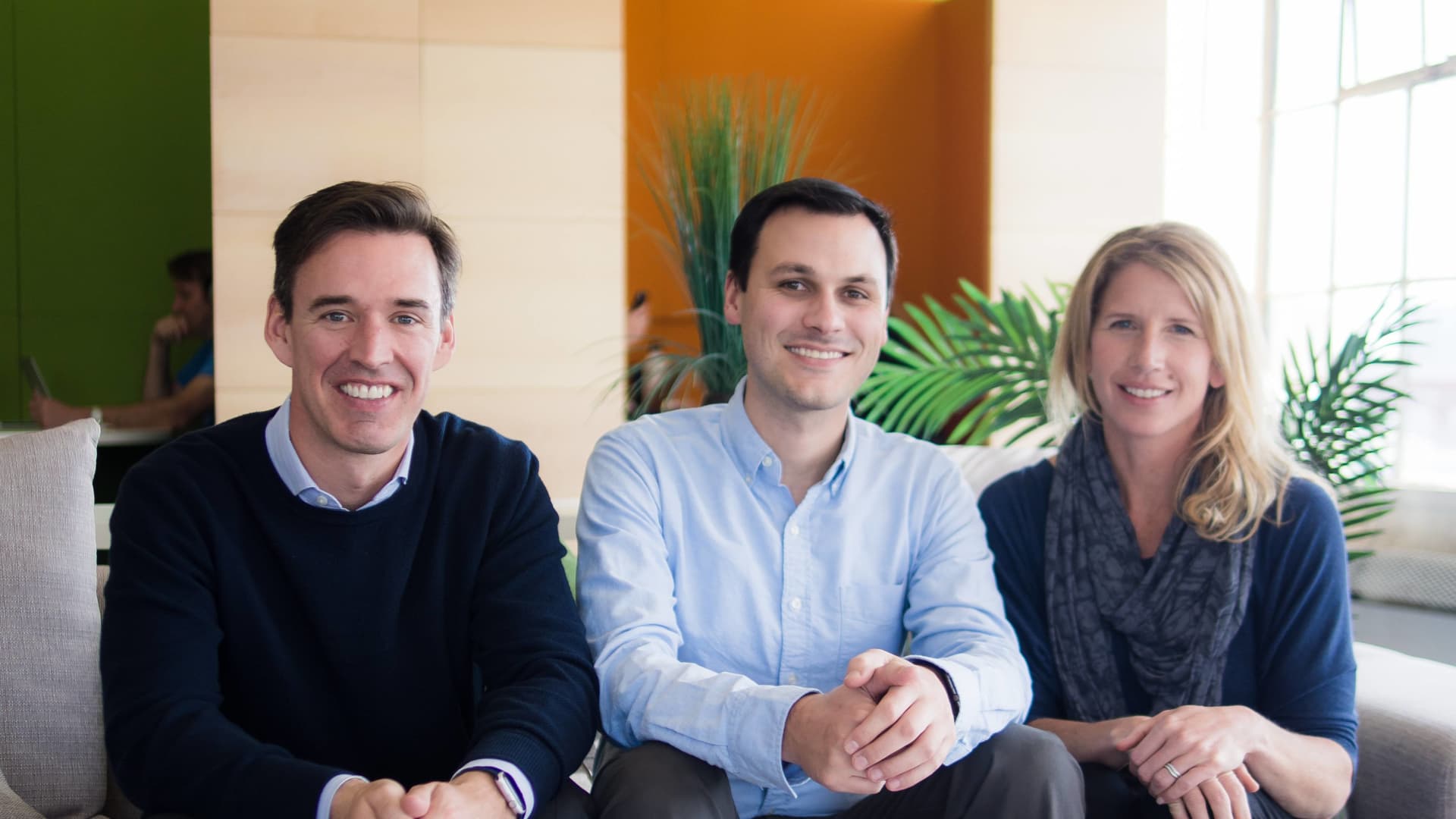- Doximity co-founder and CEO Jeff Tangney owns a $2.9 billion stake in the company after its New York Stock Exchange debut this week.
- Tangney started the company in 2010 and, prior to the IPO, hadn't raised outside capital since 2014.
- "I did resist some of the Silicon Valley wisdom of, you need to go big, you need to hire 40 more sales people and do all these things," Tangney said.
Jeff Tangney launched his first health-tech start-up, Epocrates, in the middle of the dot-com bubble. While the company survived the crash and eventually went public, the endgame was a disappointing acquisition for less than $300 million.
By the time Tangney started his next venture, Doximity, in 2010, he'd learned a few things: Don't raise too much money. Don't burn too much cash. Fix a real problem for doctors.
With Doximity, Tangney created a web service that's both a professional network — think LinkedIn for doctors — and a secure way for medical experts to communicate and share information with patients and colleagues. It now counts 1.8 million medical pros in the U.S. as users, including over 80% of physicians.
Get a weekly recap of the latest San Francisco Bay Area housing news. Sign up for NBC Bay Area’s Housing Deconstructed newsletter.
On Thursday, Doximity debuted on the New York Stock Exchange, closing the week with a market cap of almost $10 billion after raising around $500 million in its IPO. Tangney's stake is worth $2.9 billion.
Those are big numbers especially when you consider that, prior to this week, Doximity never showed up on a "unicorn" list of billion-dollar tech companies. Its last financing round in 2014 valued the company at under $400 million. Tangney said that because Doximity is profitable it still hasn't touched the $50 million it raised seven years ago.
"I did resist some of the Silicon Valley wisdom of, you need to go big, you need to hire 40 more salespeople and do all these things," Tangney, 48, said in an interview on Thursday, after ringing the bell at the NYSE.
Money Report
In Doximity's target market, there's no point in aiming for rocketship growth, Tangney said. The company generates revenue from drugmakers, who use the site to market treatments to a very targeted audience, and health systems looking to promote content to doctors across the country. It's also a recruiting tool hospitals and health centers use to fill key jobs.
Tangney recognized early on that he could expand only as rapidly as customer budgets would allow.
"The reality of health care and our clients, who are very staid institutions, a lot of non-profits that have been around for 100 years, is that even if you lean in and hire tons of sales and marketing people, they're not going to let you grow," Tangney said.
He's also not inclined to pay for branding just for the sake of building his profile — another reason why the company has remained largely unknown in Silicon Valley even though it's headquartered in San Francisco. Doximity's advertising budget for last fiscal year totaled $2.6 million, or roughly the amount Uber spends on an average day.
Tangney said the best advertising has come from doctors touting the product within their practitioner networks.
Meanwhile, the company generated over $200 million in revenue last fiscal year and produced over $50 million in net income.
Climbing trip at Stanford
Tangney's journey to Doximity started in the late 1990s while he was living in New York with a trained physician named Richard Fiedotin. From their un-air-conditioned apartment, the pair came up with the idea of creating an app for the Palm Pilot, which had just hit the market, that would allow doctors to get critical information.
Tangney and Fiedotin took that idea with them to Stanford Graduate School of Business, where they met another physician named Tom Lee. The three bonded over the intersection of tech and health care while on a teambuilding climbing trip for students in the program.
In 1998, they started what became Epocrates, and over the next two years raised about $40 million from some of Silicon Valley's top health investors. As mobile moved to BlackBerry devices and then to iPhones, Epocrates gained traction as a way for doctors to make decisions about prescriptions and patient safety while on the move.
The venture capitalists told Tangney to hire like crazy, so he did. Then came the tech crash and the crisis from the 9/11 terrorist attacks. In 2002, Epocrates was forced to cut a bunch of jobs, Tangney said.
The company held on, but it was a slog. Fiedotin left a few years later, and Lee departed to start One Medical, a chain of primary care clinics that uses technology to improve the patient experience. Tangney stuck around a bit longer, and tried to take Epocrates public. Then came the financial crisis of 2008, and the company had to withdraw its prospectus.
Tangney finally left in late 2009, a year before the eventual IPO and four years before Athenahealth bought the company for $293 million.
"There was a point during the last couple years of my tenure where it felt like we were in this tunnel, marching toward a goal," Tangney said. "I wasn't having as much fun. When you're not in that place of loving what you do, you're not doing your best work."
Tangney had spent the past decade selling products to medical centers and talking to doctors about the challenges they faced doing their jobs. He kept those conversations going and learned that communication was a constant point of stress, whether it's getting in touch with patients, other doctors, administrators or recruiters. In Tangney's estimation, 80% of communication in the industry "is done via snail mail and fax."
"Software is indeed eating the world but it kind of choked a little bit on health care," he said.
Shari Buck had worked with Tangney at Epocrates. She's one of the first people he approached with the idea of creating a professional network designed for doctors. Buck said she hopped on board "without reservation," joining as one of the three co-founders, along with Nate Gross, a doctor who is also the founder of health-tech incubator Rock Health.

"Before we had an office, Jeff would drive up to Marin to meet me," Buck said. "We would meet in a workspace above the garage. We used to laugh at how Apple it was," she said, referring to the storied location where Steve Jobs and Steve Wozniak started their computer company.
Tangney also turned to Lee as a sounding board and advisor. At One Medical, Lee had the perfect test audience for Tangney: A growing base of doctors who were enthusiastic about technology.
At the time, Tangney was not at all focused on revenue, but was rather pursuing an approach more akin to consumer internet start-ups, trying to build a big base of engaged users with the hope that money would eventually follow.
Lee said they batted around ideas for future revenue opportunities. Helping medical recruiters find talent was a clear possibility.
"Recruiting doctors is not a well-defined profession and had been done poorly," said Lee, who's now founder and CEO of health company Galileo. "A doctor receives a lot of job opportunities. In classic medical marketing, you'd get these glossy photos of opportunities that were completely outdated, showing glorious pictures of suburban communities and symphony life and fishing."
Best ideas come over cocktails
For Tangney, product development at Doximity has always been centered around what doctors need. So he created a medical advisory board a decade ago, bringing together a few dozen physicians in the network for a weekend every year.
The group gets together on a Saturday afternoon to provide feedback on new products, learn about updates that could be coming and for some general brainstorming. The talks continue informally over evening drinks and then resume Sunday morning, ending with lunch.
While Doximity had to skip this year's gathering because of Covid-19, the event has been held in Napa and at Pebble Beach, and more recently at the company's San Francisco office.
"It's been probably the biggest influence on our product roadmap," Buck said. "We talk about what we plan on building, individual features and new crazy ideas that we have. The best ideas come at cocktail hour on Saturday night."
Buck said Tangney is known for carrying around little notebooks that he diligently fills up cover to cover over the two days.
Kevin Spain of Emergence Capital attended the Napa weekend in 2012, not long after his venture firm led Doximity's first investment, a $10.8 million financing round.
Spain was thoroughly invested in Doximity's success, and not just because of the money Emergence had on the line. He wasn't yet a partner at the firm but had convinced his superiors to back a pre-revenue business. It was an atypical bet for Emergence, which focuses on early-stage cloud software companies.
Spain said that while board meetings were instructive because he could see signups going in the right direction and engagement on the site increasing, the Napa weekend was much more insightful. He got to hear directly from doctors about what they needed to improve their practice.
"They felt like they had a hand in co-creating this thing Doximity was building," said Spain, whose firm owns a $1.35 billion stake in the company as of Friday's close. "I'd never seen that before."
Some of those doctors ultimately made good money from the IPO. Doximity allocated up to 3.5 million shares to doctors on the platform, representing 15% of the offering. After Doximity's stock price jumped 115% in its first two days, the value of shares owned by doctors climbed from $91 million to over $195 million.
"Physicians are sort of outsiders in the financial markets and business world," Tangney said. "Yet in our life and world they're the insiders, they're the people we care about most. We'd rather the shares go to them if there's a pop than to some hedge fund somewhere."
One challenge for Tangney as he continues to seek expansion opportunities is that there's a finite universe of users and the core product already reaches the vast majority of them. The company serves more than 80% of U.S. physicians and over 90% of recent medical school graduates. There are only about 1 million doctors in the country.
Still, Tangney sees a decade of revenue growth ahead. There are digital ad dollars to capture as pharmaceutical companies move spending online. And there's the power of medical referrals, helping doctors get patients to the right places based on where the top experts work and which hospital specializes in treating a particular disease.

Doximity also just entered telehealth, a $4.3 billion market opportunity, according to the prospectus. As a response to the pandemic, Doximity launched a video-based virtual visit service that doctors can use from their existing app and patients can use without having to download anything.
The company said it signed over 150 telehealth subscription agreements with medical systems and served over 63 million virtual visits in the fiscal year that ended in March. Yet the product only accounts for 2% of its revenue.
At the highest level, Tangney said, health care accounts for 18% of the U.S. economy, so there's no shortage of money available if Doximity's service continues to add valuable features.
"We're steadfastly focused on these very busy million people who really take care of the sick all day and aren't given great tools to collaborate with each other easily and to make care better," he said.
WATCH: Disrupting Healthcare






